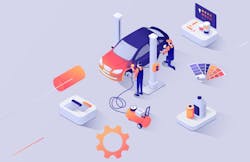Bottleneck. Traffic jam. Congestion. These are words you may have used to describe struggles in your paint department. But, often, roadblocks are simply ways to learn lessons.
The paint department is one area of body shops that can experience roadblocks, thus slowing the repair process. Or, it can be an area that contributes to a lower cycle time.
Mark Duliba would know; his refinishing team operates at nearly 200 percent efficiency. Duliba has over two decades of experience as a painter in the automotive industry. He began his career painting custom cars, and then moved onto restorations of old, classic Chevys.
Duliba, the general manager for Salinas Collision Repair in Salinas, Calif., rotates his team between painting and prepping cars in order to reduce burnout on the job.
But, rotating teams is just one secret to a paint department’s success. Duliba says his team would not be nearly as successful without the proper tools and equipment.
Derick Ware, head painter at Glaser’s Collision Centers’ four locations in Kentucky, says success is less about the tools and more about time and how the team uses their time. Ware, a 2018 FenderBender Award Winner, has an efficiency of 220 percent. He’s efficient and he’s able to get coworkers to reach his level.
Duliba and Ware share their top five essential items every paint department needs to succeed in 2020.
Focusing on the Basics
1) Paint Booth Maintenance
“If the equipment isn’t working properly then you simply cannot do your job,” Duliba says.
Duliba has a Blowtherm paint booth at his disposal and he stresses the importance of consistently performing maintenance on it. The shop has four paint booths total, with one able to do “jamming and priming in,” he says. Yet, all of the booths are over 20 years old.
Duliba is able to maintain a well-run booth by having the booth checked for maintenance at least once every six months. He completely cleans the booth. His shop is also equipped with a central vacuum system to help control dust.
“Having good housekeeping makes for a safer environment,” Duliba says.
Ware agrees it’s vital for a paint department to stay on top of maintenance. His team changes its GFS paint booth’s filters and prep station filters at least once a month.
2) Extensive Color Library
Duliba and Ware each recommend organizing a paint department’s color library so finding a color is as quick as possible.
Ware color-coordinates his color library in a binder and organizes it not by make and models but by color so, for example, reds are with reds. Every color is labeled for the OEM but is organized lightest to darkest. Also, he uses PPG’s color library, which is located in the shop’s computer system.
Duliba uses his paint company's online database to access colors. They can enter the vehicle’s paint code and different formulas come up.
“Spray-out cards are done early in the repair process to verify color, usually in the blueprinting process,” Duliba says. “They’re labeled and kept in binders as tools to use for future reference.”
He organizes his color library chromatically. He says a painter needs to have his or her own color library for times when the paint company’s formula is not the best match. The painter might have to use a completely different formula from a different vehicle maker. This happens often when the car was refinished from a previous repair.
“Over a period of time we usually run into the same type of vehicles in our markets with the same paint codes,” Duliba notes, “so having your own library will only make your paint department stronger.”
3) Spectrophotometer
Duliba often notices the spectrophotometer tool collects dust on some painter’s shelves. Why? Painters don’t know how to properly use the tool, which he believes helps match paint colors well.
In order to use the tool correctly, the surface the picture is taken of has to be completely free of any imperfections. And, polish out the existing paint color as best as possible, he says. Once the surface is swirl free and clear, take pictures of it and see what reading it shows.
Ware feels a spectrophotometer is most useful when a vehicle has a color that was sprayed on by someone else and doesn’t match his color library.
Speeding up the Process
4) UV Primers
When a job has to be delivered quicker, Ware recommends using UV primers to help accelerate the priming process. A normal primer might take about 20 to 25 minutes to dry, he says. When a painter uses a UV primer, it can take only a few minutes.
For other paint-drying processes, Ware also says a painter should be using air blowers in a paint booth to dry waterborne base paint.
The team at Salinas Collision Repair has experimented with UV primers with solid results.
5) Heat Lights
The type of lighting used in the paint department is critical. One of Ware’s most essential items for the department is heat light.
“It’s important to use heat whenever possible,” Duliba says.
His shop is equipped with heated paint booths and the team uses short wave infrared heat lamps to preheat panels prior to priming. They’re also used to cure primers after application to speed up the process.
“If the primer is applied with the panels cold and the primer isn’t allowed to come up to the recommended temperature (usually 70-80 degrees) for the product to perform as desired, the primer will not fully cure,” Duliba says. “This will result in gloss die back and possible mapping around the repair areas. The primer will not sand well and usually will finish curing in the bake cycle for the paint.”
Duliba stresses that, for tasks like color-matching, painters should use natural light. In the rest of his paint department, there are LED lights.

